Following on from Bordeaux Dry Whites being a surprise hit in our best sellers of 2014 I thought it would be good idea to turn the spotlight on Semillon . . . the grape that makes Sauvignon sing.

Semillon grapes
Sales of our Bordeaux Dry Whites (Bordeaux Blancs made from the classic blend of Semillon and Sauvignon grapes) have been booming. These lovely, structured wines were once the preserve of well informed wine afficiandos but now more and more people are waking up to their virtues.
This style of wine is reaching a wider audience thanks in part to New World Sauvignon Blanc producers who are taking the next step up in developing their wines. Their natural progression has been to experiment with Bordelaise Dry White blends using Semillon as Sauvignon’s perfect partner.
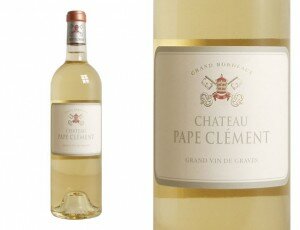
Australia has quickly adopted Semillon to blend with their Sauvignons to recreate the Bordeaux style.
The result has been that Semillon is getting more exposure. Deservedly so. This grape is used in the blend of every white produced by the Bordealise.
Prestigious Grand Cru Classe produce aristocratic Dry Whites that can evolve for decades using the Semillon and Sauvignon blend (Chateaux Haut Brion Blanc, Laville Haut Brion Blanc (now La Mission Haut Brion) and Pape Clement Blancfor example).
Similar to the following that White Burgundy commands, top flight White Bordeaux has its own loyal supporters.
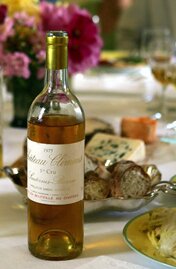
Semillon is also essential in the famous Sweet Whites of Bordeaux’s Sauternes
and Barsac. Thanks to this grapes susceptibility to Noble Rot these long lived, nectar like, dessert wines could not be made without it. All the Saturnais use Semillon, some chateaux choosing to use it unblended; Premier Cru (First Growth) Chateau Climens is a case in point.
However you don’t have to spend a fortune to buy a good White Bordeaux; there are many excellent Petits Chateaux producing affordable superb Whites.
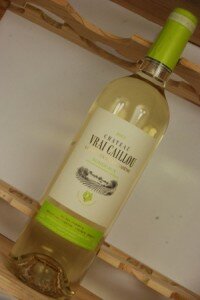
Bordeaux
Bordeaux White Blends
There are actually several grapes permitted in a White Bordeaux blend: Sauvignon Blanc and Semillon are the primary grapes.
A dash of Muscadelle is occasionally added to the blend by some chateaux. Lesser known varieties such as Sauvignon Gris, Ugni Blanc (Trebbianno), Colombard, Mauzac, Ondenc and Merlot Blanc are also permitted but are very rarely used.
Why do Semillon and Sauvignon marry so well in a blend?
Perhaps this is because they are genetically very close, although Semillon’s parentage is still a bit of a mystery. Young or unripe Semillion grapes have a similar aromatic profile to Sauvignon. Semillon compliments Sauvignon extremely well; it adds weight, structure and
density to the wine, taming the acidity of Sauvignon. In France Semillon can express flavours of lemon, honeysuckle or acacia flower, pear, fig, sweet hay or grass, peach and green apple. When used in Sweet Wines Semillon’s flavour profile deepens to complex flavours of hazelnut or almond, tropical and candied fruits. It is known for giving a rounded, honied, waxy tone to the wine.

Wine Styles
1. Dry Whites – Bordeaux Blanc. The most established blend is Semillion and Sauvignon. However a few chateaux produce a rare 100% Semillon Dry White; Sauternes Premier Cru Chateau Siglas Rabaud’s ‘La Semillante de Siglas’ and Chateau Le Puy are two examples.
2. Sweet Whites – Liqoreux (sweet) and Moelleux (semi sweet). Semillion is used to make dessert whites, many of which are 100% Semillion, although Sauvignon and/or Muscadelle can also be used in a blend.
Semillon Key Facts
Grape:
Semillon is a golden skinned grape, sometimes blushed with pink or copper. It is thin skinned and has low acidity.
A Little History:
Semillion was the most widely planted white grape in the world during the 1800s but plantings declined in France after World War II and today a group of Sauternes chateaux have formed a cooperative to preserve their Semillon clones.
Semillion is native to Bordeaux and has been grown there for over four centuries. Although it’s thought to have originated in Sauternes there is a theory that it actually comes from Saint Emilion. The grape was known as Semillon de Saint Emillion in 1736 and ‘Semillion’ could be a corruption of the town’s name. This idea is a little controversial as Saint Emilion is renowned for its red wines today rather than its whites!

Noble Rot:
Noble Rot is a little miracle worker. It’s a fungus (botrytis cinerea) that affects grapes. It shrivels the grapes, intensifying their sweetness and concentrating their flavours whilst keeping a high level of acidity.
In Bordeaux Noble Rot occurs around the little river Ciron, a tributary of the river Garonne. The AOCs that produce Sweet Whites (Sauternes, Barsac, Cerons etc) lie in the hollow where the two rivers converge. The Ciron has cooler waters than the Garonne and where the two rivers meet mist is produced. The mist descends upon the vineyards, giving the right conditions for the development of Noble Rot.
Making sweet wines from grapes with Noble Rot is labour intensive – grapes have to be hand picked so that only those with Noble Rot are selected and yields can be low. It is said that one grape vine only makes enough juice to make one glass of wine. Although these are dessert wines their sweetness is not cloying due to their zesty acidity.
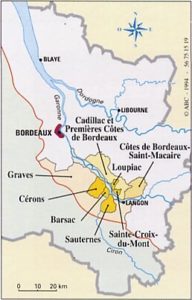
AOCs:
Many appellations can produce Dry White Bordeaux under the Bordeaux, Bordeaux Sec, Bordeaux Superieur, Premiers Cotes de Bordaux and Bordeaux Moelleux AOCs but below are a few that specialise in dry white and sweet white production, including some lesser known appellations that are worth tracking down.
Entre Deux Mers – Dry White
Graves – Dry White
Pessac Leognan – Dry White
Blaye Cotes de Bordeaux – Dry White
Cotes de Bourg – Dry White
Sauternes – Mainly Sweet White but increasingly
showing a shift to Dry White production
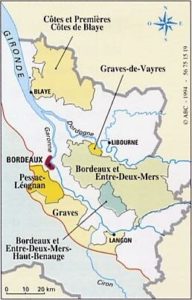
Barsac – Mainly Sweet White but also showing a shift to Dry White production
Sainte Croix du Mont – Sweet White
Loupiac – Sweet White
Cerons – Sweet White
Cadillac – Sweet White
Cotes de Francs – Dry & Sweet White
Graves de Vayres – Dry & Sweet White
Haut Benauge – Dry & Sweet White
Saint Foy – Dry & Sweet White
Saint Macaire – Dry & Sweet White
If you would like to discover Semillon for yourself we stock several Bordeaux Dry Whites from Graves and the Entre Deux Mers as well as Bordeaux Liqoreux and Moelleux from Barsac and Sauternes. Cheers!


